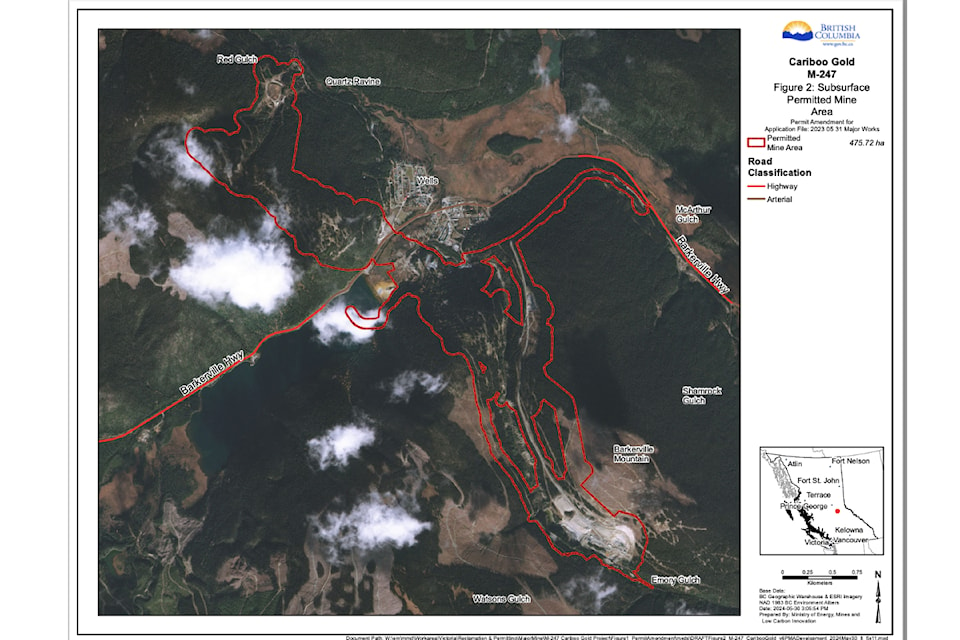A billion-dollar gold mine project expected to employ hundreds in B.C.'s Cariboo has been approved despite ongoing concern from a local First Nation.
The B.C. government has granted an operating permit under the Mines Act to Osisko Development Corporation for its Cariboo Gold Mine in Wells.
After a 13-month process, including a technical review and collaboration with First Nations, the underground mine becomes the first approved applicant entirely assessed under B.C.'s new 2018 Environmental Assessment Act.
A provincial news release says approximately 634 people will be employed during construction, with an initial $137-million investment and another $918 million over the life of the mine.
The project will be able to process around 1.1 million tonnes of gold-bearing ore per year. It will include underground mining over 16 years, ore milling at the Quesnel River Mine (approximately 58 kilometres southeast of Quesnel), storage of waste rock at the Bonanza Ledge Mine near Barkerville and a transmission line from the Quesnel area to the mine.
A permit under the Environmental Management Act (EMA) for the project is under consideration within the Ministry of Environment and Parks with a decision expected in the coming weeks. That permit would provide authority for the company to introduce and process waste under controlled circumstances
The news release noted the Environmental Assessment Office completed its assessment of the mine project with extensive consultation from experts, First Nations, including the Lhtako Den茅, Xat艣奴ll and Williams Lake First Nations, government agencies and the public.
Earlier this month, the Xat艣ull nation issued a statement calling for the project to be halted until it had granted consent.
"The province has shown it is failing to responsibly regulate this sector in our territory," Xat艣ull chief Rhonda Phillips said on Nov. 7. "It's not the 1980s anymore -- by failing to address the very serious issues raised by Xat艣ull about this project, the province and Osisko are neglecting to uphold their commitments to reconciliation and to implement DRIPA (Declaration on the Rights of Indigenous Peoples Act) and UNDRIP (United Nations Declaration on the Rights of Indigenous Peoples)."
鈥淴at艣奴ll has acted in good faith in our discussions, and we will not stand down until we are treated respectfully as partners and acknowledged as Aboriginal title holders and decision-makers."
Some of the concerns Xat艣奴ll outlined include waste water discharge into water sources such as Jack of Clubs Lake, Lowhee Creek and Rudy Creek. The Bonanza Ledge mine, which has ceased operations, was acquired by Osisko in 2020, it was fined earlier this year for discharging waste water into Lowhee Creek from April 2021 to November 2022. At the time Osisko said it was caused by historic issues with the site and it had been working to address those failures since it acquired the site.
They also have concerns about the safety of the southern mountain caribou population, which the province of B.C. labels as endangered. Their letter in 2023 says things like transmission line clearing and year-round access will further put the caribou at risk.
Osisko said it has made reasonable efforts to reach an agreement with the nation over the past two years and has offered financial benefits similar to what was agreed to by other Indigenous communities.
The Lhtako Dene Nation said in a release earlier this month that Osisko has meaningfully engaged with them and has worked collaboratively on projects surrounding salmon and caribou conservation.
"We support and look forward to the sustainable development of the Cariboo Gold," the release said.
Osisko CEO Sean Roosen says getting the construction and operating permits mark a major milestone for it and its stakeholders.
The Environmental Assessment Act was modernized to enhance public confidence, transparency and meaningful participation, to advance reconciliation with First Nations, and to deliver stronger environmental protections, while supporting sustainable economic development.
With files from Canadian Press and from Andie Mollins, Local Journalism Initiative Reporter




